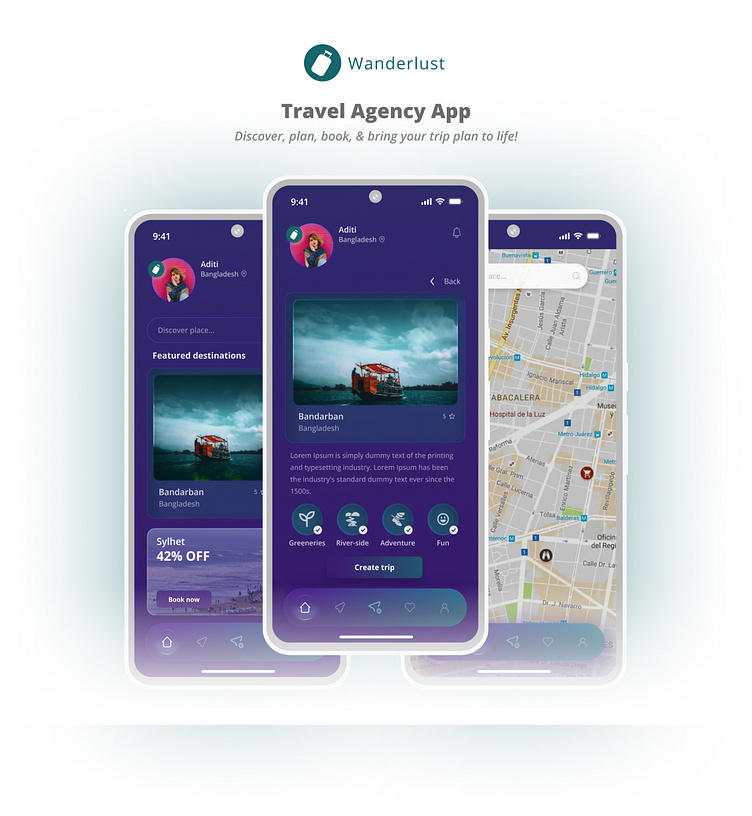Travel Companion Mobile App UI Design
Understanding Project Details, and Value Propositions
Understanding project details, value propositions, and assessing market gaps are crucial in Digital Product Design for several reasons. First, a clear grasp of project details enables designers to make informed decisions that align with both user needs and business objectives. This understanding leads to the development of a compelling value proposition, ensuring that the product effectively communicates its benefits to potential users, thereby attracting and retaining them.
Moreover, assessing market gaps allows designers to identify opportunities for innovation, ensuring the product addresses unfulfilled user needs and stands out in a competitive landscape. This focus on user-centric design not only enhances user satisfaction and engagement but also reduces the risk of developing products that lack market demand, ultimately saving resources and time.
N.B. Additionally, clear project details foster better collaboration among team members and stakeholders, leading to a more cohesive and efficient design process. Together, these elements contribute to the creation of successful digital products that resonate with users and meet business goals.
Empathizing with the Real Users
Empathizing with real users is a cornerstone of effective Digital Product Design, offering several key advantages. First, it fosters a deeper understanding of user needs, motivations, and pain points, allowing designers to create solutions that genuinely resonate with their target audience. This user-centric approach enhances the overall user experience, leading to increased satisfaction and loyalty.
Additionally, by involving real users in the design process through interviews, surveys, and usability testing, designers can gather valuable feedback that informs iterations and improvements. This iterative process not only results in more intuitive and functional products but also reduces the risk of costly revisions after launch.
N.B. Moreover, empathizing with users helps build a strong emotional connection, which can differentiate a product in a crowded market. Ultimately, this focus on understanding users leads to designs that not only meet functional requirements but also create meaningful interactions, driving engagement and success.
Competitive Assessments, and Assessing Market Gap
Competitive assessments in Digital Product Design offer several significant advantages. First, they provide valuable insights into industry trends and best practices, helping designers understand what works well in the market. This knowledge allows teams to identify strengths and weaknesses in their own products relative to competitors, enabling informed decision-making for enhancements and innovations.
Additionally, competitive assessments can uncover gaps in the market, revealing opportunities for differentiation. By understanding what competitors offer, designers can tailor their products to meet unique user needs and preferences, ultimately increasing market appeal.
N.B. Furthermore, analyzing competitors helps anticipate potential challenges and pitfalls, allowing teams to strategize effectively and mitigate risks. Overall, competitive assessments are essential for creating compelling, user-centric products that stand out in a competitive landscape.
Synthesizing User Data, and Getting Ready Insights to Action
Synthesizing user data and transforming insights into actionable steps is vital in Digital Product Design, offering several key advantages. First, it enables designers to distill vast amounts of user feedback and behavioral data into clear, meaningful patterns that inform design decisions. This targeted approach helps ensure that the final product aligns closely with user needs and preferences.
By effectively synthesizing data, teams can identify critical pain points and opportunities for improvement, leading to more intuitive and user-friendly designs. This process also facilitates quicker iterations, as actionable insights allow for rapid prototyping and testing based on real user input.
N.B. Moreover, translating insights into action fosters a more agile design process, enabling teams to adapt to changing user requirements and market conditions. Ultimately, this approach enhances the overall user experience, drives engagement, and increases the likelihood of product success.
Ideating Solutions, Creating User-flows, Information Architecture Building, Wire-framing, KPIs Measure, Iteration, Hi-fidelity Design, and Prototype
N.B. If you are interested to learn more about my further design thinking process, please feel free to get into my figma design file. Please click on
I'm open for new project!
https://mdrahman.framer.website/
My name is Md Masudur Rahman, a Google-certified UX Designer and a full-time freelancer who gives offers in completely remote environment. I've got a wide range of experience in establishing product's back-end architecture (UX Research), improving UI design, and overall enhancing User Experience. There are a lot of terms like, understanding user needs and expectations, defining problem statements, evaluating ideas, performing competitive audits, features prioritization, wire-framing, building Hi-fidelity design, prototyping, and user testing before you finalize a solid UI Design.
👉Professional connections : LinkedIn
Feel free to follow and connect.
"Let's discuss about how your product's unique value proposition's going to get aligned with your business goals."














